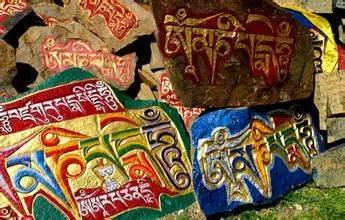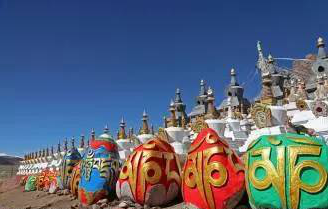Like the locals: How to pray in Tibet
- 甘蓓蓓

- Apr 3, 2019
- 3 min read
Updated: Apr 16, 2019

Its endless landscape, high mountains and unique culture make Tibet a truly mysterious place. One visit might not be enough to grasp every part of the Tibetan culture, be it the customs, the food or – simply - everyday life, so we asked our friends in Tibet to share with us how their life differs from ours.
The first article will give you a brief insight into three common forms of prayer in Tibet.
1) Fengma Banner (Tibetan Sutra Streamer)
Those who have been to Na Jin Mountain probably noticed the piles of colorful Sutra streamers, covering the mountain paths, right away. The streamers, with the printed scriptures clearly visible when the sun shines through and their bright colors, are a favorite subject for photographers and anybody who visits Tibet.
“Sutra Banners”, “Mani Flags” or “Prayer Flags” – the streamers have many names. However, due to the horse (ma) inprinted on most of them, as a wish to ride with the wind (feng) and to spread the prayers everywhere, they’re often referred to as Fengma Banners. They’re hung up in order to pray for blessings, for protection or to show devout respect to the gods.
The hanging streamers usually consist of a set of five colors, with each color having its own meaning: blue (the sky), white (the clouds), red (the fire), yellow (the land) and green (the water). It is said that the longer the Fengma Banner is knotted and the higher it is hung, the better the luck it brings will be. Therefore, some Fengma Banners can reach several hundred meters in length, for example those hanging over the Shantou Gorge.
2) Mani Stone
Mani stones – also called “Mansa” or “Stone Offering” - can be found almost everywhere in Tibet and are one of the most popular forms of prayer. The stones, inscribed with the six syllabled mantra Ohm Padme Mani Hum, have two direct meanings. One is to pray for blessing; the other is for people to correct their thoughts and behaviors at any time.
In some places, Mani stones were piled up due to the belief that stacking stones is equivalent to reading the scriptures. Such Mani stone mounds – or "Mani Dui" - are a place where the worshippers talk to the gods. Also, because these stacked stones cannot be moved easily, they are said to be conveying the prayers to the gods day after day.
However, Mani stone are not only used to communicate with the gods, they also have a rather practical function: Mani Stones, as well as Mani stone mounds, also exist as signposts, which was especially essential in the old days. Since the plateau was only scarcely populated, visitors could not tell which way to go when they passed through a fork in the road or in the mountains. The Mani stone was placed at the entrance, junction and turn of the pass to help people identify it, so it had the dual function of guiding the way and communicating with the gods.
3) Prayer Wheel
Pictures or videos about Tibet often show Tibetan people constantly rotating a cylindrical wheel on a spindle with one hand, while they are touching a series of similar wheels with the other. These wheels are so-called prayer wheels and can be seen throughout Tibet.
Prayer wheels are generally divided into two categories: one is hand-operated and consisting of a cylindrical wheel on a spindle, while the other one is often much bigger in size and fixed on the wheel frame of the temple. Both types of prayer wheels are made of gold, silver or copper and contain one – or more – tightly wound scrolls printed with the mantra Om Padme Mani Hum. Spinning the wheel is believed to bring the same benefits as reading the mantra out loud, with each cycle counting as one repetition of the prayer. Same as with the Mani stones, the principle of “the more, the better” applies. With the rapid rotation of the cylinder, the person determines that his or her value is also rapidly accumulating.
Traditionally, the wheels are rotated with a light hand shake, however, recent years have seen a number of wheels powered by electric motors and containing several mantras.























コメント